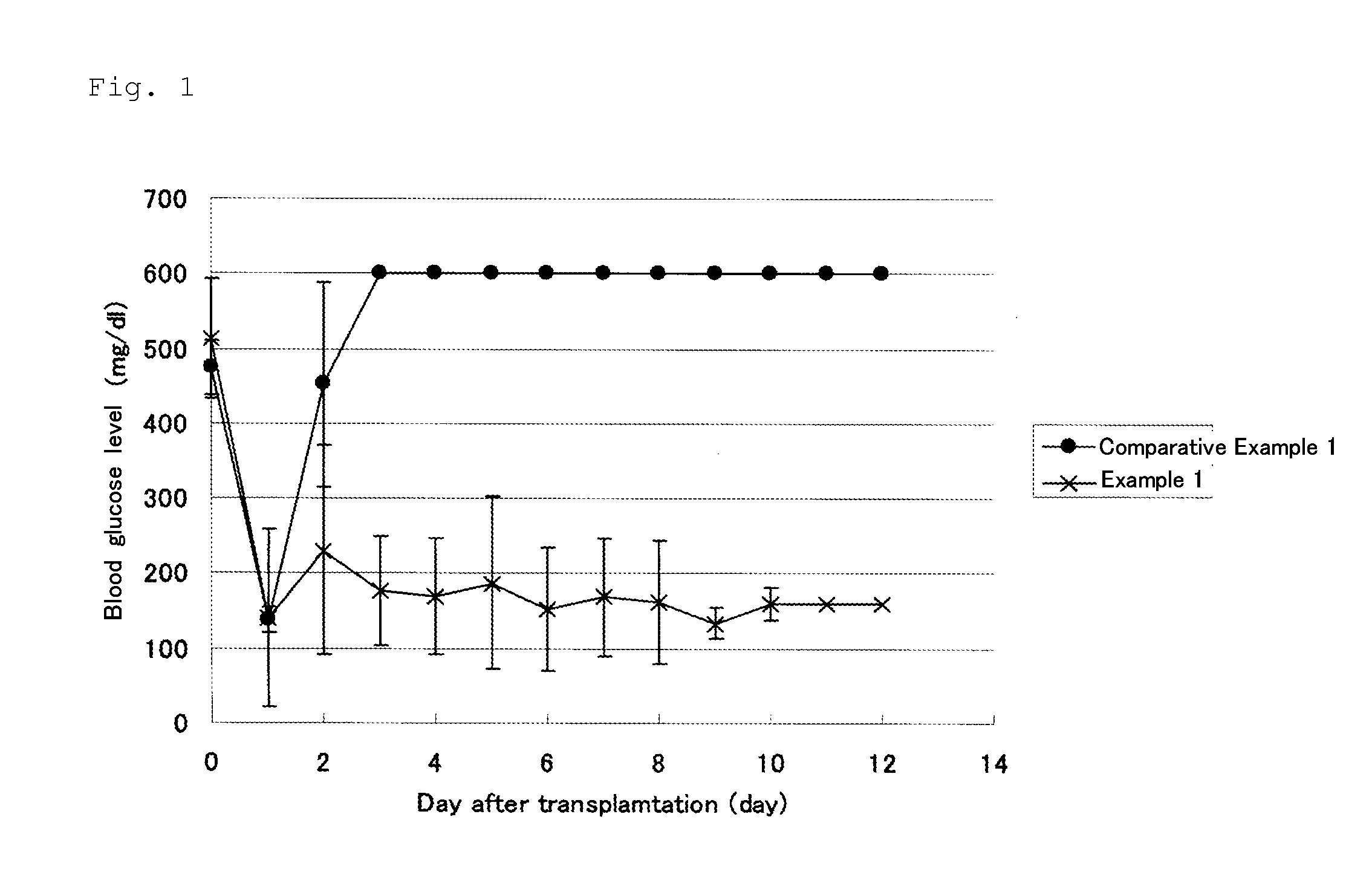Islets of langerhans transplant using islets of langerhans and adipose tissue derived stem cells
- Summary
- Abstract
- Description
- Claims
- Application Information
AI Technical Summary
Benefits of technology
Problems solved by technology
Method used
Image
Examples
example 1
Hybrid Transplantation of Adipose Tissue-Derived Stem Cells and Pancreatic Islets
1. Collection of Adipose Tissue-Derived Stem Cells
[0086]Adipose tissue-derived stem cells were extracted from mice following the procedure described below.
(1) C57BL / 6J mice (CLEA Japan, Inc.) were anesthetized, an antiseptic solution was applied thereto, and the mice were shaved with a razor.
(2) Adipose tissue (subcutaneous adipose tissue and visceral adipose tissue) was extracted from the mice, weighed, and placed in a 50-mL tube holding 20 mL of PBS (phosphate buffered saline) that contained an antibiotic (Antibiotic Antimycotic Solution (100×); Sigma; A5955-100ML)
(3) The adipose tissue was washed by mixing in a 50-mL tube. The washing process was repeated three times while exchanging the PBS containing the antibiotic.
(4) The washed adipose tissue was added to 10 mL of a culture medium (DMEM, high glucose) containing 10 mg of collagenase (type II) (Collagenase; Sigma; C 6885-500MG) and 100 μL of antib...
example 2
Evaluation of Survival Rate of Pancreatic Islets Transplanted to Mouse
[0090]The blood glucose levels of the C57BL / 6J mice that had been subjected to islet transplantation in Examples 1 and Comparative Example 1 were measured with time for 11 days.
[0091]The results are shown in FIG. 1. The C57BL / 6J mice to which pancreatic islets (200 islets) were transplanted alone showed an increase in blood glucose level from the 3rd day after the transplantation and onward. These findings revealed that the transplanted islets were not grafted. In contrast, in the C57BL / 6J mice to which adipose tissue-derived stem cells (2×105 cells) were transplanted simultaneously with pancreatic islets (200 islets), the blood glucose was lowered to a normal level and maintained even 11 days after the transplantation. This confirmed that the transplanted islets were sufficiently engrafted.
[0092]Considering the fact that the number of pancreatic islets (200 islets) employed in this experiment is equivalent to hal...
example 3
Evaluation of Glucose Tolerance of Pancreatic Islets Transplanted Mice
[0094]On day 10, a 0.4-M glucose solution was injected into the abdominal cavity of the C57BL / 6J mice that had been subjected to islet transplantation in Example 1 and Comparative Example 1 in an amount of 2 g / kg body weight to perform an intraperitoneal glucose tolerance test (IPGTT). The blood glucose levels were measured with time until 120 minutes had passed from the injection. As controls, the IPGTT was performed under the same conditions as described above, using C57BL / 6J mice that were made diabetic (DM, hereunder referred to as diabetic model mouse) and using normal BALB / cA mice (Normal), and the blood glucose levels thereof were measured with time.
[0095]FIG. 3 shows the results. In the C57BL / 6J mice to which only pancreatic islets (200 islets) were transplanted, a high blood glucose level was observed even 120 minutes after the application of the glucose load, the glucose tolerance was not normalized, and...
PUM
 Login to View More
Login to View More Abstract
Description
Claims
Application Information
 Login to View More
Login to View More - R&D
- Intellectual Property
- Life Sciences
- Materials
- Tech Scout
- Unparalleled Data Quality
- Higher Quality Content
- 60% Fewer Hallucinations
Browse by: Latest US Patents, China's latest patents, Technical Efficacy Thesaurus, Application Domain, Technology Topic, Popular Technical Reports.
© 2025 PatSnap. All rights reserved.Legal|Privacy policy|Modern Slavery Act Transparency Statement|Sitemap|About US| Contact US: help@patsnap.com



